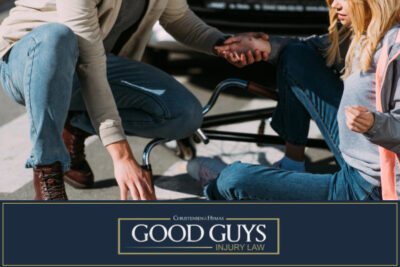
Biking is an excellent way to stay active, reduce carbon footprint, and enjoy the outdoors. However, with the increasing number of cyclists, practicing bicycle safety is essential to avoid bike accidents.
At Good Guys Injury Law, we are committed to helping you stay safe while riding your bike. This article will provide safety tips to avoid bike accidents and reduce the risk of serious injury.
Table of Contents
The Importance of Bicycle Safety

Cycling can be a fun and efficient mode of transportation, but it also comes with risks. Bicycle accidents can result in crash-related injuries or even fatalities. Many bicyclist deaths occur due to collisions with motor vehicles. Whether you’re an experienced cyclist or just starting, following bike safety tips can help you ride safely and prevent accidents.
1. Wear a Helmet
One of the most critical safety tips for cyclists is always wearing a helmet. A bike helmet is designed to protect your head in case of a fall or collision. Wearing a helmet significantly reduces the risk of a head injury, which can be life-threatening.
Make sure your helmet is properly fitted and meets safety standards. If you’re unsure, you can get your helmet fitted at a local bike shop.
2. Use Reflective Gear and Lights
Visibility is key to preventing accidents. Wear reflective clothing or bright clothing during both day and night rides to make yourself more visible to other vehicles and reduce the risk of bicycle injuries.
In low-light conditions, a red rear light and a bright white light on the front of your bike can help other cars and cyclists see you. Remember to add rear lights and reflectors to your bike as well.
3. Follow Traffic Laws
Cyclists are required to follow the same road rules as motor vehicles. This includes stopping at stop signs, obeying street signs, and riding in the same direction as traffic.
When you approach a red light or pedestrian signal, stop completely and wait for the signal to change. Following traffic laws helps you stay predictable to drivers and reduces the risk of accidents.
4. Stay in the Bike Lane
Use bike lanes or designated bike paths to keep a safe distance from motorized vehicles whenever possible. Riding in a bike lane reduces the chance of getting too close to other vehicles and helps protect you from potential collisions.
Avoid sidewalk riding in areas with heavy pedestrian traffic, as this can lead to accidents with pedestrians.
5. Be Cautious at Intersections
Intersections are one of the most common places where bicycle accidents occur. When approaching an intersection, slow down, ensure eye contact with drivers, and signal your intentions clearly. For example, extend your left arm straight out to indicate a left turn.
Always be aware of car pulls and other cars that may turn suddenly.
6. Watch Out for Parked Cars
Car doors opening suddenly into your path can cause severe cycling injuries. When riding near parked cars, maintain a safe distance and stay alert.
If you see a driver inside a parked car, assume they may open their door without checking for oncoming cyclists. This common hazard can be avoided by being vigilant and riding in the correct lane position.
7. Avoid Distractions
Just like driving a car, cycling requires your full attention. Avoid using a mobile phone or listening to music while riding.
Staying focused on the road and your surroundings can help you react quickly to potential dangers, such as other cyclists, pedestrians, or unexpected obstacles.
8. Be Extra Careful in Urban Areas
Cycling in urban areas presents unique challenges due to higher traffic volumes and complex road layouts. Side streets, parking lots, and busy intersections require extra caution.
Always assume that other vehicles may not see you, especially when navigating parking lots or making turns on the side streets.
9. Signal Your Movements
Using hand signals is an essential part of bike safety. Before turning or changing lanes, signal your intentions to drivers and other cyclists.
For instance, to indicate a left turn, extend your left arm straight out. This helps to prevent accidents by letting others know what you plan to do.
10. Ride Defensively
Defensive riding means being aware of your surroundings and anticipating the actions of other vehicles. Always be prepared for sudden stops or swerves, and avoid riding too close to the edge of the road, where debris can cause you to lose control.
Assume drivers may not see you and be ready to take evasive action if necessary.
11. Be Mindful of Lane Position
Lane position is vital for staying safe on the road. Bicyclists traveling too close to the curb or edge of the road may risk encountering obstacles or debris.
Conversely, riding too far into the lane can put you in the path of motor vehicles. The best practice is to ride in a position that allows you to be visible to drivers while avoiding hazards.
12. Regularly Maintain Your Bike
Keeping your bike in good working order is essential for safe riding. Regularly check your brakes, tires, and gears at a local bike shop. A poorly maintained bike can lead to accidents, such as brake failure or tire blowouts. Don’t forget to check the reflectors and lights on your bike to ensure they are functioning correctly.
The Risks of Not Following Bicycle Safety Tips

Failing to follow bicycle safety guidelines can lead to serious injury or death. Bicyclist deaths often occur because of collisions with motor vehicles, many of which could be prevented by following the safety tips outlined above. Whether riding in a busy city or a quiet neighborhood, taking precautions can save your life.
Understanding the Impact of Bicycle Accidents
When a bicycle accident occurs, the consequences can be severe. Cycling injuries can range from minor cuts and bruises to crash-related injuries like broken bones or head injuries. In some cases, these accidents can result in long-term disabilities or even bicyclist deaths. Comprehending the potential risks underscores the importance of bike safety.
Common Causes of Bicycle Accidents
Bicycle accidents can happen for a variety of reasons, including:
- Failure to yield: Not yielding to traffic when required can lead to collisions, especially at intersections.
- Distracted riding: Using a mobile phone or not paying attention to the road increases the risk of accidents.
- Ignoring traffic signals: Running red lights or not stopping at stop signs is a leading cause of accidents involving cyclists.
- Improper lane position: Riding too close to the curb or in the wrong part of the lane can lead to accidents with motor vehicles.
Preventing Serious Injuries
By following safety tips to avoid bike accidents, you can reduce injuries and lower your risk of being involved in one. Wearing a helmet, using reflective gear, and obeying street signs are just a few steps to stay safe. Remember, bike safety is not just about protecting yourself but also others on the road.
Moving Forward After a Bicycle Accident
Taking the right steps is essential if you’ve been involved in a bicycle accident. Here’s what you should do:
1. Seek Medical Attention
Even if you feel fine after an accident, seeking medical treatment is imperative. Some injuries, like concussions or internal injuries, may not show symptoms immediately but can be serious. Getting prompt medical care ensures that your injuries are documented, which is essential if you need to file a claim.
2. Document the Accident Scene
Take photos of the accident scene, your bike, and any visible injuries, if possible. These photos can be valuable evidence if you need to make a legal claim. Also, make a note of any street signs or traffic laws that were relevant to the accident.
3. Contact an Attorney
If you’ve been injured in a bicycle accident, consulting an experienced attorney can help you determine your rights and options. At Good Guys Injury Law, we offer a free consultation to discuss your case and help you determine the best course of action.
4. Report the Accident
Make sure to report the accident to the police and your insurance company. Filing a police report ensures that the accident is officially documented, which can be important for insurance claims or legal proceedings.
Contact Good Guys Injury Law for Bike Accident Safety Tips

Cycling is a healthy and enjoyable activity, but it’s essential to prioritize safety to avoid bicycle accidents. Following these safety tips can reduce the risk of serious injury and ensure a safer bike ride. Remember to always wear a helmet, use reflective clothing, and follow the same rules as motor vehicles on the road.
At Good Guys Injury Law, we are committed to helping cyclists stay safe and informed. If you or a loved one has been injured in a bicycle accident, please contact us for a free consultation.
